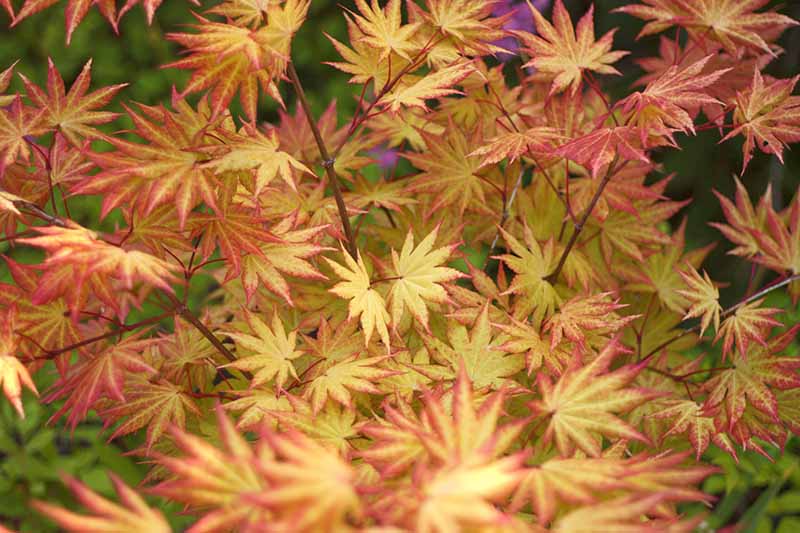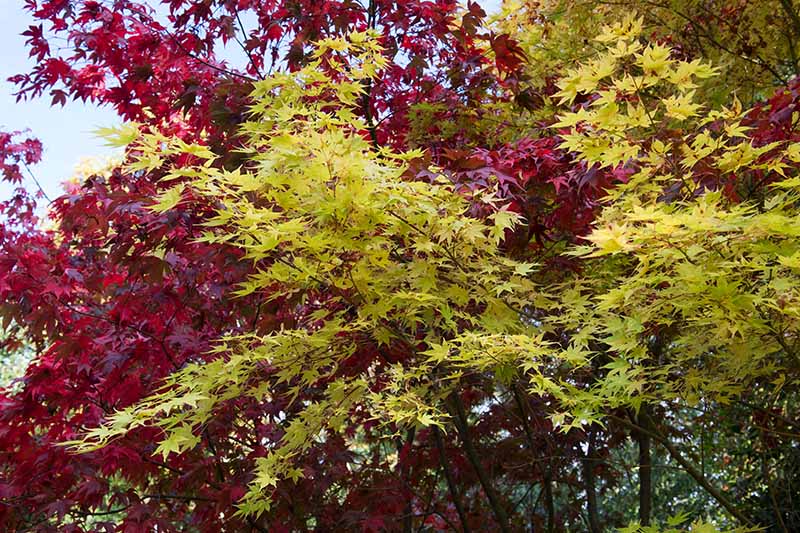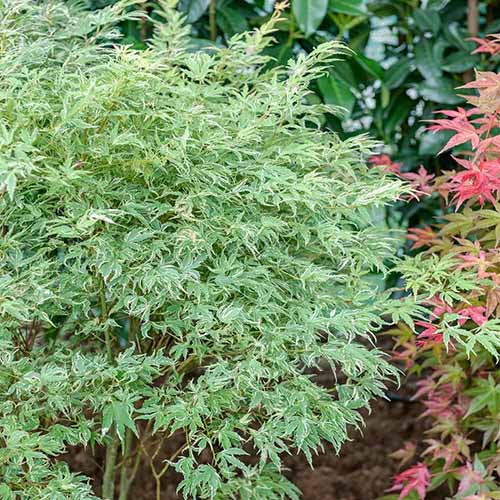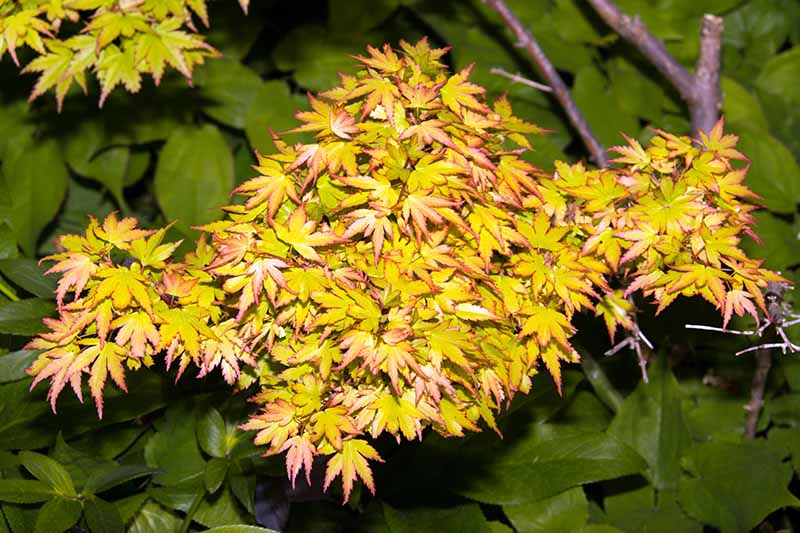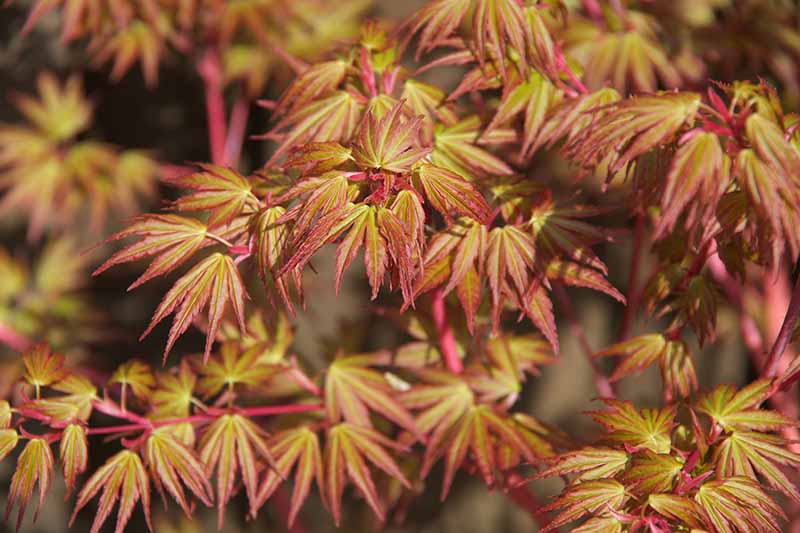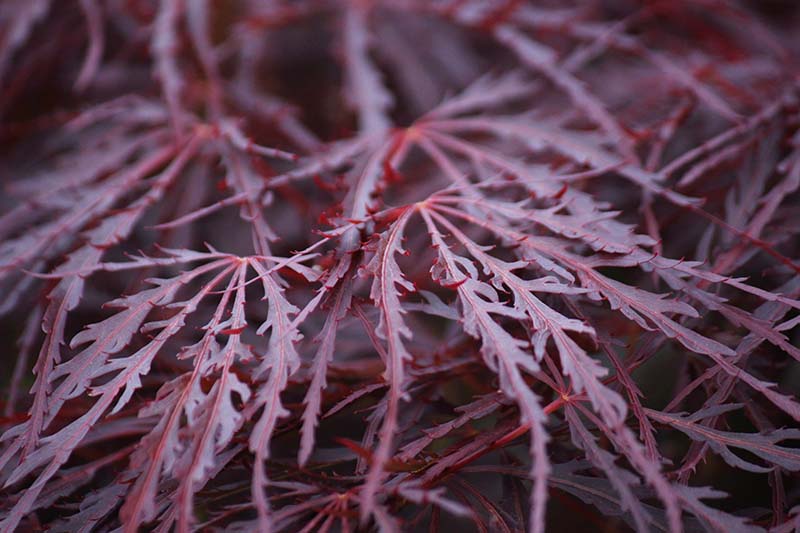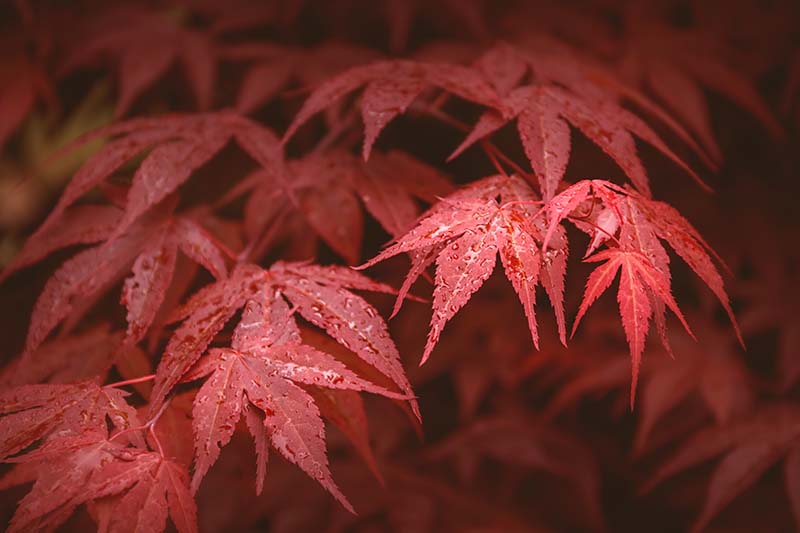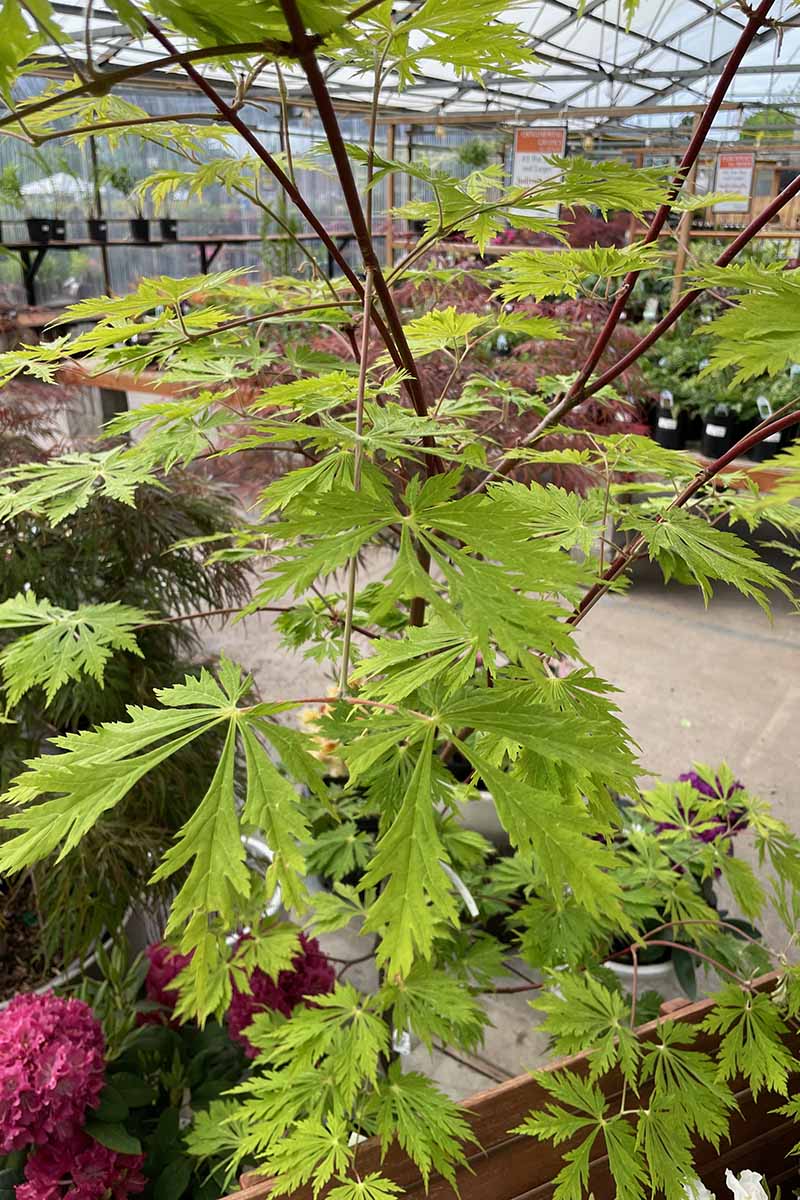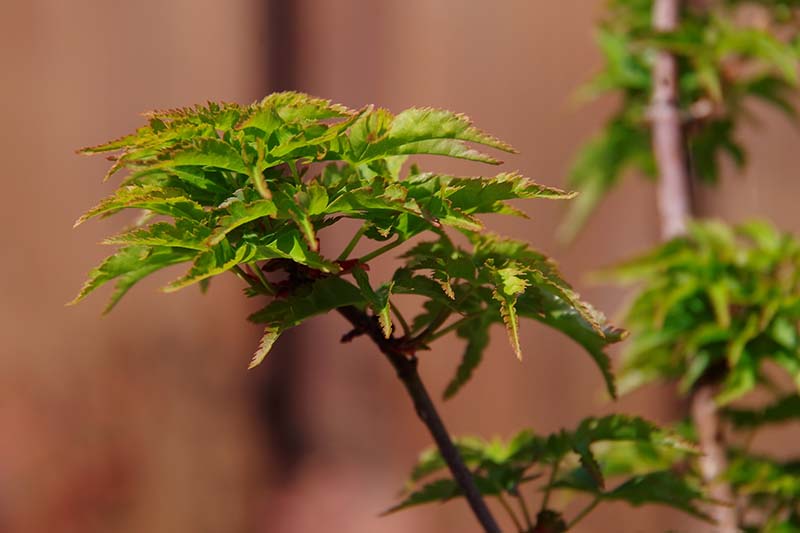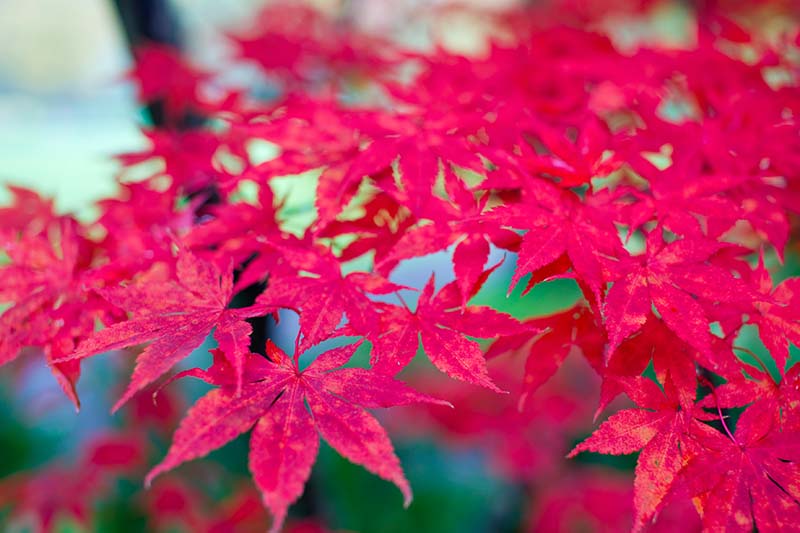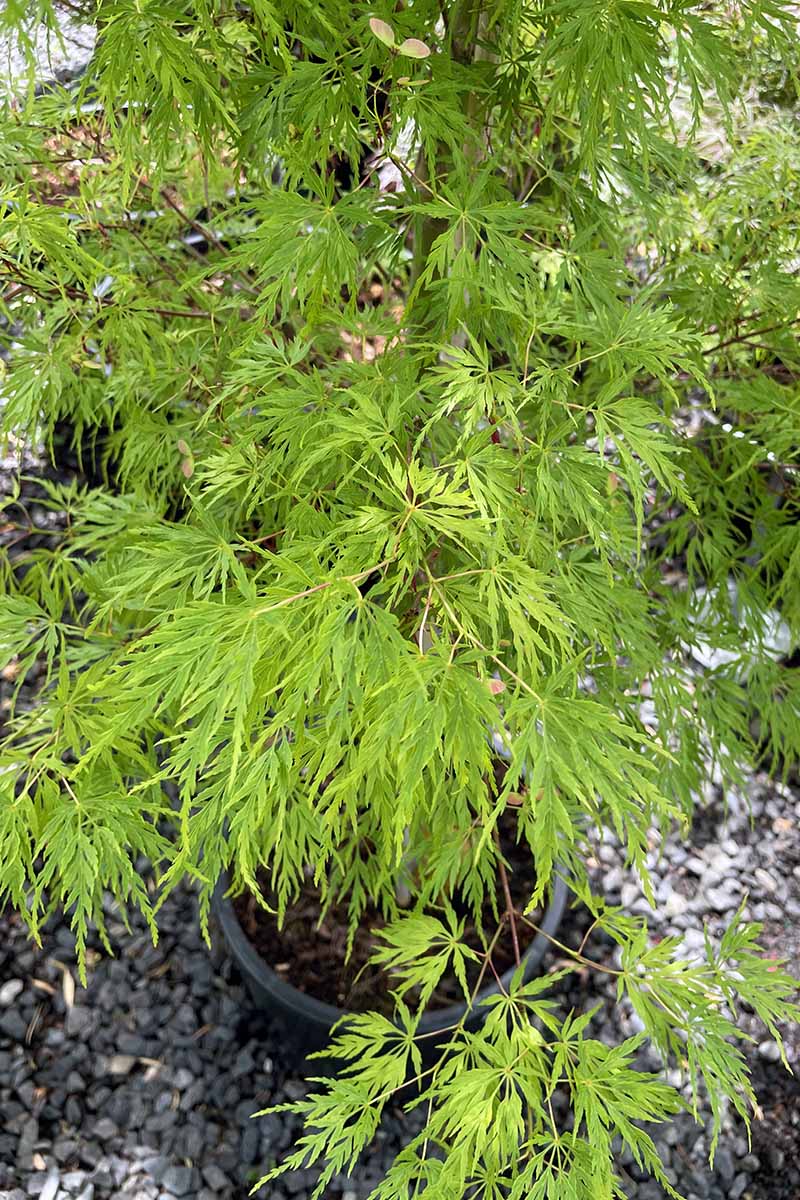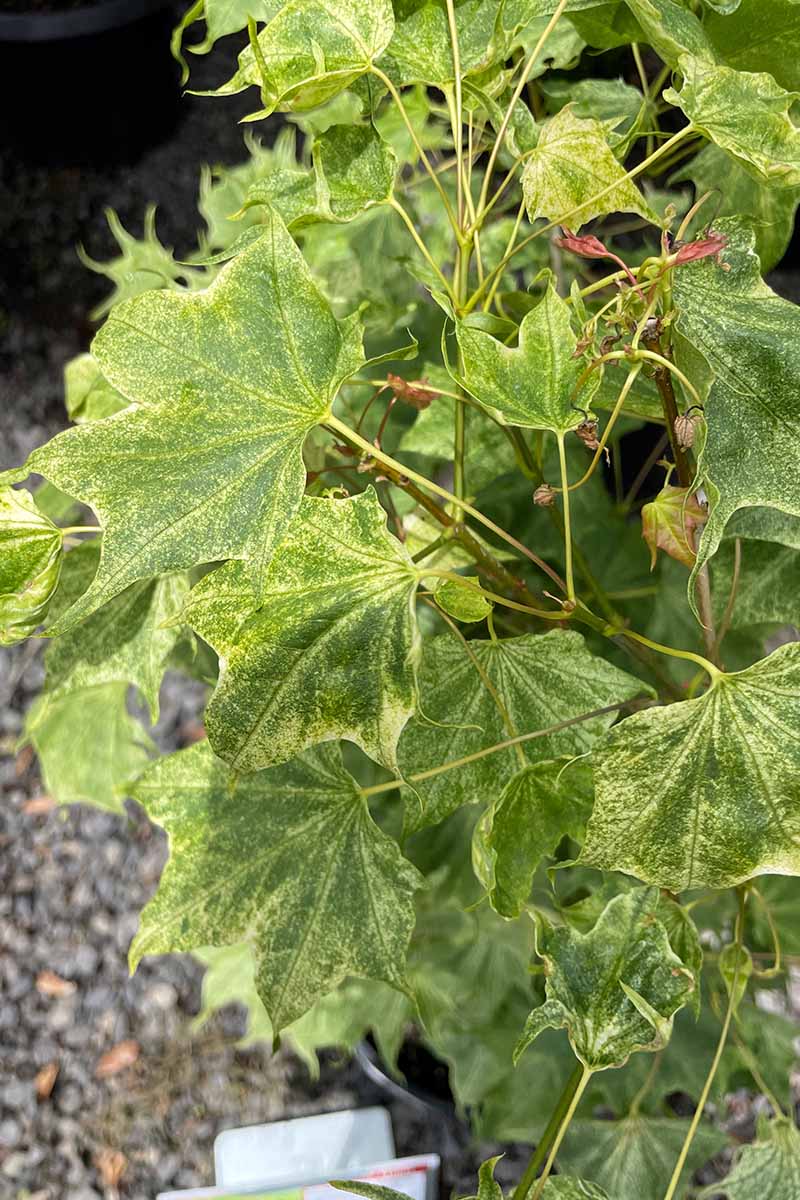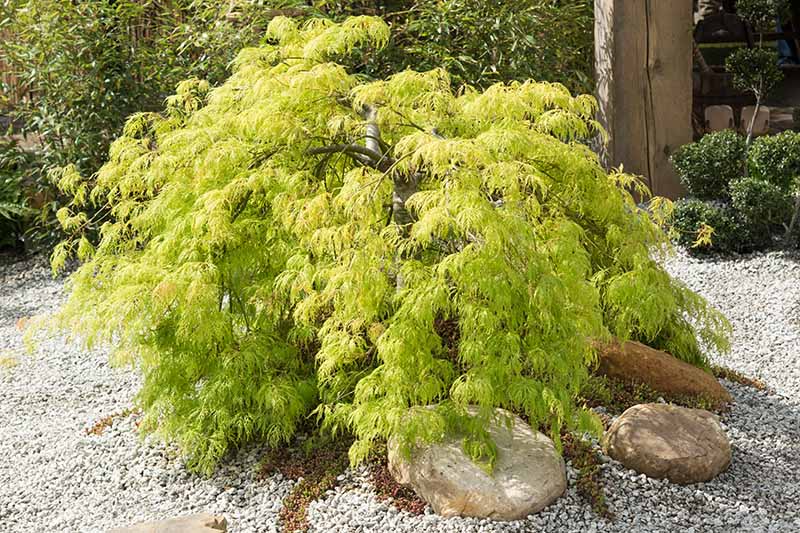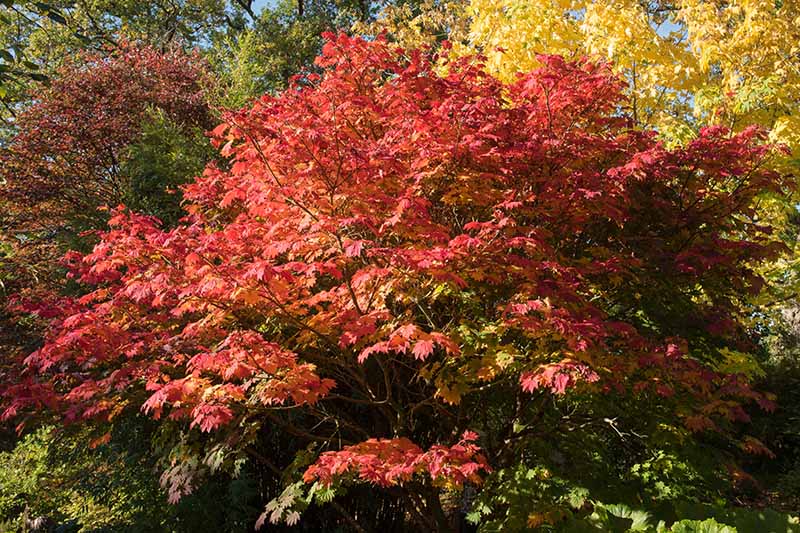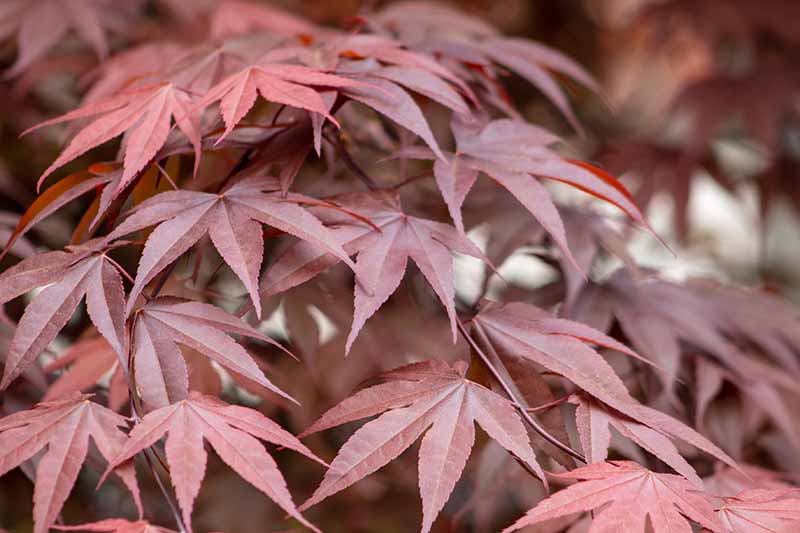Plus, there are so many size, shape, and growth combinations available, you’re sure to find what you need to add height, texture, or color to a garden display. Chances are, if you need a small tree to add interest to your own garden, there’s a Japanese maple that fits the bill. We link to vendors to help you find relevant products. If you buy from one of our links, we may earn a commission. That said, the marvelous variation available is also what makes shopping for one of these trees a bit challenging. A well-stocked nursery can be downright overwhelming! Whether they are particularly hardy, exceptionally beautiful, or one of the more popular or unique trees out there, there’s something on this list for everyone who is in the market for a Japanese maple to grow at home. Here are the trees you’re about to learn all about: There are some pretty incredible trees on this list, so let’s jump right in!
1. Autumn Moon
Obviously, I love all my Japanese maple children equally. But if there is one tree that I tend to show off just a bit more than the others, it’s A. shirasawanum ‘Autumn Moon.’ This upright tree stays fairly compact, topping out at about 12 feet, though it takes years to reach that point. But its size isn’t its most exceptional aspect. The foliage is the real knockout feature. In the spring, it’s yellow and orange before shifting to salmony-red during the summer. In the fall, it changes to vibrant orange and red.
3. Butterfly
A. palmatum ‘Butterfly’ stands out because it has medium-green leaves with distinct silvery white margins. It grows best in Zones 5 to 8, and needs full sun to really show its color. ‘Autumn Moon’ You can find two- to three-foot ‘Autumn Moon’ plants available from Fast Growing Trees.
2. Beni Kawa
A. palmatum ‘Beni Kawa’ isn’t just beautiful when it’s dressed up in its full summer foliage. It has bright coral-colored bark that makes a striking statement in the winter garden as well. At under 10 feet tall and wide, it won’t crowd out the rest of the plants in your landscape. It also has a lovely arching growth habit. ‘Beni Kawa’ ‘Beni Kawa’ thrives in warmer areas than some other cultivars, and it’s suited to Zones 5 to 9. And some leaves may be entirely green while others are entirely silvery white, giving the entire tree a lovely variegated appearance. The deeply lobed leaves are pink as they first emerge in the spring before turning bright green in the summer. In the fall, the foliage becomes bright red with small patches of yellow. ‘Butterfly’ needs partial sun and only grows in Zones 6 to 8. When mature, it reaches up to 12 feet tall and eight feet wide with an upright growth habit. ‘Butterfly’ You can find two- to three-foot ‘Butterfly’ plants available for purchase at Fast Growing Trees.
4. Coonara Pygmy
A. palmatum ‘Coonara Pygmy’ stays petite, only growing to about ten feet tall – about half the size of some larger Japanese maples – with an upright habit. It’s hardy in Zones 6 to 9.
5. Coral Bark
A. palmatum ‘Sango Kaku’ is another Japanese maple with bright coral bark. Its name means “coral tower.” The color becomes more intense as the seasons become cooler.
6. Crimson Queen
An incredibly popular tree, ‘Crimson Queen’ is a dwarf A. palmatum cultivar. Once mature, this striking tree stands with an upright habit at 20 to 25 feet tall. ‘Coral Bark’ ‘Sango Kaku’ is ideal if you want something that not only adds color to the yard during the growing season, but also during the dormant winter months. Sound good? Nature Hills Nursery carries this plant in #2 containers. Read more about growing coral bark varieties here. It’s wider than it is tall, eventually growing to about eight feet tall and 12 feet wide, with elegantly weeping branches. Its shape can add some interesting dimension to your garden. The foliage can appear to have a different hue depending on the amount of light it receives. In partial sun, the lacy leaves are maroon.
7. Emperor One
This cultivar looks similar to the exceptionally popular ‘Bloodgood,’ but differs in that it only grows to about 15 feet tall with an upright growth habit. It’s hardy in Zones 5 to 8. ‘Crimson Queen’ ‘Crimson Queen’ is hardy in Zones 5 to 9. To nab one for your yard, head to Nature Hills Nursery, where you can purchase a three-year-old plant. This A. palmatum cultivar is one the hardiest maples out there, rarely suffering from pests and diseases.
8. Green Cascade
A. japonicum ‘Green Cascade’ is an upright full moon maple that grows in Zones 5 to 7, and reaches about 20 feet tall and 25 feet wide. ‘Emperor One’ Our friends at Nature Hills Nursery carry this beauty in #2 containers. With rounded and palmate foliage, somewhat resembling a fern, the deeply lobed and heavily serrated emerald green leaves turn bright red and yellow in the fall. In the garden, the effect is extremely impressive. It’s almost like having a massive, shade-providing fern in your garden.
11. Koto Ito Komachi
No guide to Japanese maples would be complete without the lovely, classic A. palmatum cultivar ‘Koto Ito Komachi.’ The leaves bud out with a green base enveloped in a bright pink exterior. ‘Higasayama’ As the leaves open, they reveal a creamy pink display before turning deep green with creamy margins. This A. palmatum is happiest in Zones 5 to 8, with an upright, open growth habit that tops out at about 18 feet tall.
10. Hogyoku
Gardeners in Zones 5 to 9 can grow this elegant A. palmatum, also known as the “Golden Jewel of Fall.” While ‘Hogyokou’ is beautiful all summer with its green, yellow, orange, and slightly red-tinged leaves, it’s the bright pumpkin orange color it displays in the fall that really stands out. ‘Hogyoku’ This upright tree is medium-sized when mature, at about 15 feet tall and 10 feet wide. This is a cultivar that does better in full sun than many others. The leaves on this tree have five string-like lobes and are light green in the summer before turning bright orange in the fall. It almost resembles a tiny weeping willow, and grows upright to just six feet tall and five feet wide when mature. Hardy in Zones 6 to 9, you can grow it in Zone 5 if it’s in a protected spot.
12. Lion’s Mane
A. palmatum ‘Shishigashira,’ also known as ‘Lion’s Mane,’ doesn’t look like your average maple. The leaves grow packed close together and they’re a deep, glossy green with wrinkled margins. At summer’s end and into fall, it gradually turns yellow and orange. ‘Lion’s Mane’ stays under six feet tall with an upright habit, and is hardy in Zones 6 to 9. The leaves may burn at the tips if grown in direct sun in hot climates.
13. Osakazuki
For fall color, it’s hard to beat ‘Osakazuki.’ This A. palmatum tree has intensely bright orange-scarlet leaves in the autumn that stay on the tree for several weeks. In spring and summer, the leaves are bright green. Each leaf has seven lobes and serrated edges. ‘Osakazuki’ won the Royal Horticultural Society Award of Garden Merit in 1993. Best suited to Zones 5 to 8, it grows up to 25 feet tall and 15 feet wide with an upright, rounded shape.
14. Red Dragon
Hardy in Zones 5 to 8, the popular ‘Red Dragon’ is compact with a tidy, weeping growth habit. This A. palmatum cultivar stays extremely small, just six to eight feet wide and tall when mature.
15. Scolopendrifolium
If you want something a little different, get your hands on ‘Scolopendrifolium,’ also known as ‘Shinobuga Oka.’ The summer hue is an extremely dark burgundy, changing to a luminescent red in autumn that practically glows from within. ‘Red Dragon’ The leaves on this A. palmatum tree have incredibly long, narrow lobes that are divided down to the base. In the summer, the leaves are bright green, while the stems, seed pods, and blossoms are all red. The overall effect is impressive. This upright, spreading, 15-foot tree appears to be covered in delicate green straps with the red adding a striking contrast, and it grows well in Zones 5 to 9.
16. Seiryu
Every single other green lace-leaf maple that we know of has a weeping or cascading growing habit. ‘Seiryu’ is credited as being the only strong upright grower with green lacy leaves. It doesn’t grow terribly tall, staying under 15 feet, but it usually maxes out closer to 10 feet.
17. Usugumo
If you want a maple that will really stand out, seek out A. pictum ‘Usugumo,’ a rare painted leaf batwing maple. ‘Seiryu’ This leaf shape isn’t common and it looks nothing like the deeply-lobed foliage that most people are familiar with. In the spring, this stunner emerges with soft pink leaves that change to green in the summer. From far away, the leaves look like they are a uniform soft, pale green, but up close, you can see that they are actually variegated. Each leaf has a deep green base with green veins, and cream or pale yellow mottling. In the fall, the leaves turn pale yellow. This upright tree does best in Zones 5 to 9 and is perfect for a small space or container. It never grows taller than about seven feet.
18. Velvet Viking
This gorgeous A. palmatum specimen may look delicate with its lovely lacey leaves, but it’s actually quite sturdy, and it is hardy in Zones 4 to 9. A dwarf cultivar, ‘Velvet Viking’ has an elegant weeping form, spreading low and wide. At maturity, it reaches only three feet tall and five feet wide. The purple-red foliage turns an intense, bright red in the fall.
20. Viridis
If you want a lacy, green A. palmatum Japanese maple that you can grow in a container or a small area, ‘Viridis’ is an excellent choice. The foliage is deeply lobed so that each leaf almost looks like it has five or more string-like fingers. ‘Villa Taranto’ It does well in Zones 5 to 8, and can be grown in full sun in cooler areas, or part shade in hotter spots. It only grows to six feet tall and wide, but can easily be pruned to stay about four feet tall and three feet wide. Its growth habit is a gracefully mounding cascade.
21. Vitifolium
A. japonicum ‘Vitifolium’ has foliage that almost looks like grape leaves, which turn intensely gold and scarlet in the fall. In the spring, they are bronze as they emerge and open, at which point they begin to turn a vivid green. ‘Viridis’ Pick up your own two-year-old live tree at Nature Hills Nursery. Plus, it has beautiful burgundy flowers in the spring. Most maples aren’t noted for their blossoms, but this one is because of the way the blooms stand out against the bright green foliage. ‘Vitifolium’
There Are So Many Japanese Maples to Love
We weren’t kidding when we said there are a ton of different Japanese maples to choose from! This really is an incredibly varied group of trees, and that’s part of their charm. But now, you hopefully have a better idea of which one is perfect for your space. If so, I genuinely want to hear about which one you end up picking for your garden. Pictures, too, please! Reach out below in the comments. And for more information about Japanese maple trees, check out the following guides next:
A Guide to the Different Types of Japanese Maple TreesHow and When to Fertilize Japanese Maple TreesHow to Propagate Japanese Maples from Seed

